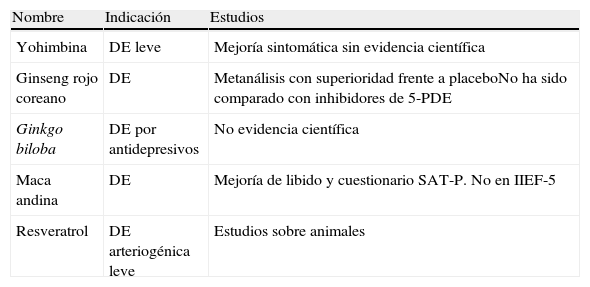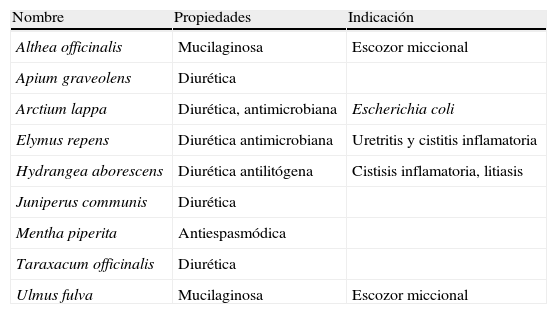Evaluar la utilidad de la fitoterapia en urolitiasis, infecciones urinarias, disfunción eréctil (DE) y prostatitis crónica/dolor pélvico crónico (PC/DPC).
Adquisición de la evidenciaRevisión sistemática de la evidencia publicada hasta enero del 2011 empleando los términos científicos: fitoterapia, litiasis urinaria, prostatitis crónica, dolor pélvico crónico, disfunción eréctil, infección urinaria, cistitis y los nombres científicos de los compuestos siguiendo las normas del Código Internacional de Nomenclatura Botánica. Las bases de datos utilizadas fueron Medline y The Cochrane Library. Se incluyeron artículos publicados hasta enero del 2011 en español/inglés. Se incluyeron estudios in vitro/in vivo sobre modelos animales o seres humanos. Los criterios de exclusión fueron literatura no española/inglesa o artículos con graves defectos metodológicos.
Síntesis de la evidenciaSe incluyeron 86 artículos y se seleccionaron 40 que cumplieron los criterios de inclusión. En urolitiasis hay pocos trabajos en humanos. El fitato tiene su principal utilidad como prevención y en la disminución del crecimiento de fragmentos residuales tras litotricia extracorpórea por ondas de choque (LEOCH). En PC/DPC el único compuesto que ha demostrado eficacia fue el extracto de polen en un ámbito de tratamiento multimodal. En DE no hay evidencia a favor del uso de la fitoterapia. La mayoría de los trabajos presentan limitaciones en el diseño o escaso tamaño muestral. En infecciones urinarias la mayoría de los productos son diuréticos. Solo existe evidencia para el arándano rojo como prevención en mujeres jóvenes o embarazadas. No debe emplearse como tratamiento de las infecciones urinarias.
ConclusionesLa fitoterapia muestra utilidad en las infecciones urinarias de repetición y en la PC/DPC. Tiene cierto papel en la urolitiasis y carece de utilidad en la DE.
To assess the usefulness of phytotherapy in urolitiasis, urinary tract infections, erectile dysfunction (ED) and chronic prostatitis/chronic pelvic pain (CP/CPP).
Acquisition of the evidenceSystematic review of the evidence published until January 2011 using the following scientific terms:phytotherapy, urinary lithiasis, Chronic prostatitis, chronic pelvic pain, erectile dysfunction, urinary tract infection, cystitis and the scientific names of compounds following the rules of the International Code of Botanical Nomenclature. The databases used were Medline and The Cochrane Library.We included articles published until January 2011 written in English and Spanish. We included studies in Vitro/in vivo on animal models or human beings. Exclusion criteria were literature not in English and Spanish or articles with serious methodological flaws.
Synthesis of the evidenceWe included 86 articles selecting 40 that met the inclusion criteria. In Urolitiasis there are few works in humans. The phytate has its main use as prevention and in reducing the growth of residual fragments after extracorporeal shock wave lithotripsy (ESWL). In CP/CPP the only compound that has shown effectiveness was the extract of pollen in a field of multimodal treatment. In DE ther is no evidence for the use of herbal medicine.Most of the works have limitations in the design or low sample size. In urinary tract infections most of the products are diuretics .There is only evidence for the cranberry as prevention in young or pregnant women. It must not be used as a treatment for urinary tract infections.
ConclusionsPhytotherapy is usefull in repeat urinary tract infections and the CP/CPP. It has some role in the urolitiasis and lacks useful in the DE.
Artículo
Comprando el artículo el PDF del mismo podrá ser descargado
Precio 19,34 €
Comprar ahora












